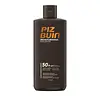What's inside
What's inside
 Key Ingredients
Key Ingredients

 Benefits
Benefits

 Concerns
Concerns

 Ingredients Side-by-side
Ingredients Side-by-side

Octocrylene
UV AbsorberC12-15 Alkyl Benzoate
AntimicrobialEthylhexyl Salicylate
UV AbsorberButyl Methoxydibenzoylmethane
UV AbsorberBis-Ethylhexyloxyphenol Methoxyphenyl Triazine
Skin ConditioningHexylene Glycol
EmulsifyingIsopropyl Isostearate
EmollientTriacontanyl Pvp
HumectantGlyceryl Stearate
EmollientPEG-100 Stearate
Caprylyl Glycol
EmollientTribehenin
EmollientAluminum Starch Octenylsuccinate
AbsorbentPotassium Cetyl Phosphate
EmulsifyingAcrylates Copolymer
Disodium EDTA
Sodium Hydroxide
BufferingPentaerythrityl Tetra-Di-T-Butyl Hydroxyhydrocinnamate
AntioxidantTocopheryl Acetate
AntioxidantPhenoxyethanol
PreservativePotassium Sorbate
PreservativeParfum
MaskingOctocrylene, C12-15 Alkyl Benzoate, Ethylhexyl Salicylate, Butyl Methoxydibenzoylmethane, Bis-Ethylhexyloxyphenol Methoxyphenyl Triazine, Hexylene Glycol, Isopropyl Isostearate, Triacontanyl Pvp, Glyceryl Stearate, PEG-100 Stearate, Caprylyl Glycol, Tribehenin, Aluminum Starch Octenylsuccinate, Potassium Cetyl Phosphate, Acrylates Copolymer, Disodium EDTA, Sodium Hydroxide, Pentaerythrityl Tetra-Di-T-Butyl Hydroxyhydrocinnamate, Tocopheryl Acetate, Phenoxyethanol, Potassium Sorbate, Parfum
Water
Skin ConditioningButyloctyl Salicylate
Skin ConditioningCaprylic/Capric Triglyceride
MaskingCaprylyl Glycol
EmollientCarthamus Tinctorius Oleosomes
EmollientCellulose Gum
Emulsion StabilisingCetearyl Alcohol
EmollientCitric Acid
BufferingCoco-Glucoside
CleansingCocos Nucifera Oil
MaskingDicaprylyl Carbonate
EmollientDiisooctyl Succinate
EmollientDimethicone
EmollientEthylene/Propylene/Styrene Copolymer
Ethylhexyl Methoxycrylene
Skin ConditioningEthylhexylglycerin
Skin ConditioningEuterpe Oleracea Fruit Oil
Skin ConditioningGluconolactone
Skin ConditioningGlycerin
HumectantHectorite
AbsorbentHydroxyethyl Acrylate/Sodium Acryloyldimethyl Taurate Copolymer
Emulsion StabilisingHydroxyethylcellulose
Emulsion StabilisingCI 77491
Cosmetic ColorantCI 77499
Cosmetic ColorantIsononyl Isononanoate
EmollientMaleated Soybean Oil Glyceryl/Octyldodecanol Esters
Mica
Cosmetic ColorantMicrocrystalline Cellulose
AbsorbentNiacinamide
SmoothingParfum
MaskingPhenoxyethanol
PreservativePolyhydroxystearic Acid
EmulsifyingPolysorbate 20
EmulsifyingPolysorbate 60
EmulsifyingPongamia Pinnata Seed Extract
Skin ConditioningSodium Benzoate
MaskingSodium Stearoyl Glutamate
CleansingSorbitan Isostearate
EmulsifyingSorbitan Oleate
EmulsifyingTetrasodium Glutamate Diacetate
Theobroma Grandiflorum Seed Butter
Skin ConditioningCI 77891
Cosmetic ColorantTocopherol
AntioxidantTriethoxycaprylylsilane
Benzyl Salicylate
PerfumingCitronellol
PerfumingLimonene
PerfumingWater, Butyloctyl Salicylate, Caprylic/Capric Triglyceride, Caprylyl Glycol, Carthamus Tinctorius Oleosomes, Cellulose Gum, Cetearyl Alcohol, Citric Acid, Coco-Glucoside, Cocos Nucifera Oil, Dicaprylyl Carbonate, Diisooctyl Succinate, Dimethicone, Ethylene/Propylene/Styrene Copolymer, Ethylhexyl Methoxycrylene, Ethylhexylglycerin, Euterpe Oleracea Fruit Oil, Gluconolactone, Glycerin, Hectorite, Hydroxyethyl Acrylate/Sodium Acryloyldimethyl Taurate Copolymer, Hydroxyethylcellulose, CI 77491, CI 77499, Isononyl Isononanoate, Maleated Soybean Oil Glyceryl/Octyldodecanol Esters, Mica, Microcrystalline Cellulose, Niacinamide, Parfum, Phenoxyethanol, Polyhydroxystearic Acid, Polysorbate 20, Polysorbate 60, Pongamia Pinnata Seed Extract, Sodium Benzoate, Sodium Stearoyl Glutamate, Sorbitan Isostearate, Sorbitan Oleate, Tetrasodium Glutamate Diacetate, Theobroma Grandiflorum Seed Butter, CI 77891, Tocopherol, Triethoxycaprylylsilane, Benzyl Salicylate, Citronellol, Limonene
Ingredients Explained
These ingredients are found in both products.
Ingredients higher up in an ingredient list are typically present in a larger amount.
Caprylyl Glycol is a humectant and emollient, meaning it attracts and preserves moisture.
It is a common ingredient in many products, especially those designed to hydrate skin. The primary benefits are retaining moisture, skin softening, and promoting a healthy skin barrier.
Though Caprylyl Glycol is an alcohol derived from fatty acids, it is not the kind that can dry out skin.
This ingredient is also used as a preservative to extend the life of products. It has slight antimicrobial properties.
Learn more about Caprylyl GlycolParfum is a catch-all term for an ingredient or more that is used to give a scent to products.
Also called "fragrance", this ingredient can be a blend of hundreds of chemicals or plant oils. This means every product with "fragrance" or "parfum" in the ingredients list is a different mixture.
For instance, Habanolide is a proprietary trade name for a specific aroma chemical. When used as a fragrance ingredient in cosmetics, most aroma chemicals fall under the broad labeling category of “FRAGRANCE” or “PARFUM” according to EU and US regulations.
The term 'parfum' or 'fragrance' is not regulated in many countries. In many cases, it is up to the brand to define this term.
For instance, many brands choose to label themselves as "fragrance-free" because they are not using synthetic fragrances. However, their products may still contain ingredients such as essential oils that are considered a fragrance by INCI standards.
One example is Calendula flower extract. Calendula is an essential oil that still imparts a scent or 'fragrance'.
Depending on the blend, the ingredients in the mixture can cause allergies and sensitivities on the skin. Some ingredients that are known EU allergens include linalool and citronellol.
Parfum can also be used to mask or cover an unpleasant scent.
The bottom line is: not all fragrances/parfum/ingredients are created equally. If you are worried about fragrances, we recommend taking a closer look at an ingredient. And of course, we always recommend speaking with a professional.
Learn more about ParfumPhenoxyethanol is a preservative that has germicide, antimicrobial, and aromatic properties. Studies show that phenoxyethanol can prevent microbial growth. By itself, it has a scent that is similar to that of a rose.
It's often used in formulations along with Caprylyl Glycol to preserve the shelf life of products.